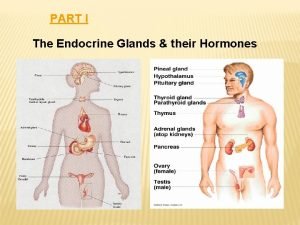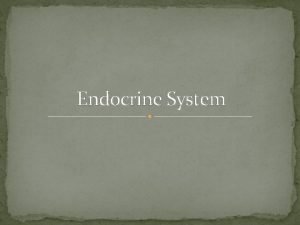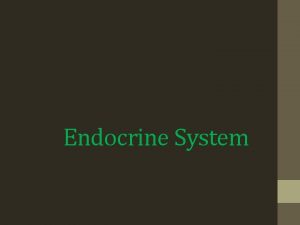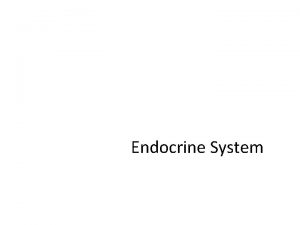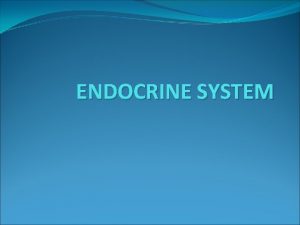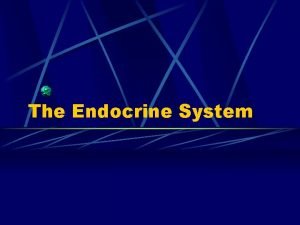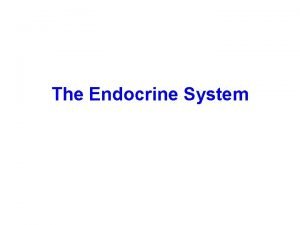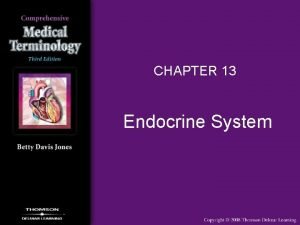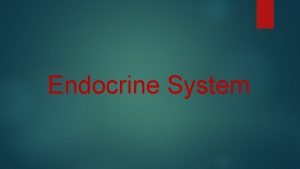ENDOCRINE SYSTEM Module 4 Training Endocrine System Like












- Slides: 12

ENDOCRINE SYSTEM Module 4 - Training

Endocrine System Like the nervous system, the endocrine system helps to control and coordinate the functions of the body’s systems But the endocrine system doesn’t use electrical signals that travels down the nerves, The endocrine system uses hormones that travel through the blood stream Hormones are detected by receptors on cells Each hormone has a specific receptor

Two types of Hormones Peptide (Polypeptide) Hormones Bind to receptors that are located on the cell membrane This causes a cascade of events in the cell that result in a change of some kind in the cell’s function or in the steps leading to protein synthesis

Peptide (Polypeptide) Hormones

Two types of Hormones Steroids Enter the cell, combine with a receptor in the cytoplasm, and bind to a specific site on the DNA located in the cell nucleus This binding stimulates the RNA transcription/translation processes, resulting in the synthesis of proteins

Steroid Hormones

Hormones Many hormones are produced and released by glands

Hormones Not simple one-task molecules Cause different cell functions based on the type of cell being bound Interact with other hormones or molecules to alter their own function Hormone concentrations are not constant Naturally vary within a day (diurnal variation) Vary day to day (eg. Menstrual cycles) Respond to stress (exercise)

Catecholamines Epinephrine, norepinephrine, dopamine Function Vasoconstriction of non-working tissue blood supply allowing blood redistribution (leads to increased blood pressure) Causes an increase in energy availability via metabolic enzyme activity and increase in contraction rate Influence on central nervous system leads to increased force production Acute Response Polypeptide hormones Nervous system causes an increase Chronic Adaptation Chronic exposure to high levels causes body to decrease catecholamine level at submaximal level, at maximum exercise level higher levels are still released

Cortisol Function Acute Response Increased as a result of resistance training, particularly when volume is high and rest periods are short Chronic Adaptations Stimulation of gluconeogenesis (convert amino acids to glucose) Increased activity of enzymes that degrade proteins (proteolysis) Inhibition of protein synthesis No consistent findings, chronic higher levels are associated with impaired immune function and overtraining Manipulating Cortisol (and other adrenal hormone) release Perform a high volume of repetitions Exercise large muscle groups Take short rest periods

Growth Hormone (Somatotropin) Functions Acute Response Increases with both resistance training (especially longer duration/higher repetitions and shorter rest periods) and aerobic exercises Women have higher GH levels than men and a higher response than men (may be due to interactions of other hormones) Chronic Response Increased lipolysis, fat metabolism, collagen synthesis and cartilage growth, renal function and retention of electrolytes Enhanced immune cell function and spares glucose No consistent findings, more research needed Stimulating GH Through Resistance Training High intensity exercises that result in elevated lactate levels (10 RM) Multiple sets (at least three)

Testosterone Function Acute Response Increases with heavy resistance exercise in men, unsure of response in females Chronic Adaptation Stimulates protein production and expression of male sex characteristics Increase after two years of intense training in males, unsure with females Manipulating Testosterone Response Exercises that use large muscle mass Heavy loads (85 -95% 1 RM) Moderate to high volume (multiple sets and exercises) Short rest intervals (30 to 60 seconds)
 Sympathetic nervous system
Sympathetic nervous system Endocrine system and reproductive system
Endocrine system and reproductive system Endocrine system vs nervous system
Endocrine system vs nervous system Lympathic
Lympathic Endocrine vs nervous system venn diagram
Endocrine vs nervous system venn diagram Endocrine system
Endocrine system C device module module 1
C device module module 1 Chapter 16 matching questions 20-24
Chapter 16 matching questions 20-24 Parts of the endocrine system
Parts of the endocrine system Comparison of endocrine and nervous system
Comparison of endocrine and nervous system Gonads glands
Gonads glands Facts about the endocrine system
Facts about the endocrine system Endocrine system of rat
Endocrine system of rat








